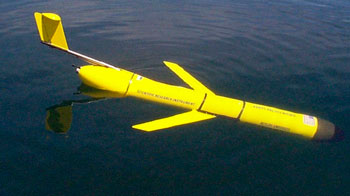Northeast Ocean Planning Meeting Rescheduled
Fishermen’s Voice Staff

Propellerless drones are the centerpiece of the “Gliderpalooza” US/Canadian project to produce the most complete image of the Atlantic’s mysterious deep waters. There are satellite maps and of the surface, etc., but these battery powered gliders dive in sweeping curves taking images of temperatures, currents and formations to record a 3D view for the first time.
The Northeast Regional Planning Body, which leads the nation’s ocean planning effort, has rescheduled its October meeting for January 22-24, 2014. The meeting is at the Hyatt Regency Hotel, 575 Memorial Drive, Cambridge, MA (1-888-253-1628).
The short version of what the RPB is setting out to do is developing a plan for siting ocean based energy projects and other industrial development projects. One goal is to minimize impacts on existing users such as commercial and recreational fishing and other marine uses. The January meeting in Cambridge is important because the Northeast Regional Ocean Council (NROC) will be setting the trajectory for how the process moves forward.
The RPG is building on the work of the 8 year-old NROC effort which is also responsible for completing the regios ocean plan. The NROC holds one or two major regional meetings like the upcoming Cambridge meeting annually. There are also small public comment meetings scheduled. In addition the states have or are establishing their own advisory meetings on the ocean planning process.
Interested parties can find meeting schedules and keep up with the process at: northeastoceancouncil.org.
The increased demand for ocean space and the inability to address this demand under current mandates is
driving the need for a more comprehensive approach to ocean management. The planning council is calling for stakeholder engagement in the process. The ocean planning process began in 2012 and is expected to be complete in 2015.
The fishing industry is facing greater challenges to its traditional practices, use of ocean space and resources. The coming decades will see things change on the water. The next 18 months may be the last time stakeholders will have a chance to influence how things changes. Commercial shipping is increasingly presenting a challenge. The expansion of the Panama Canal and the increasingly ice-free Arctic are contributing to an increase I commercial shipping in the northeast. Two other high profile newer uses actively seeking sites are aquaculture and renewable energy.
Stakeholder engagement is being called for in the planning process. Commercial shipping, energy development and the military are considered to be in a better position, organizationally, to benefit from being engaged stakeholders. Commercial fishing may increase it’s access through the NROC’s website and the fishing organizations and government agencies participating in the planning process.
The pressure from increased ocean use could result in historic changes in how the regional ocean is used and who can use it.
The RPB website has a “data portal” on it’s website which allows public access to information including maps showing areas of the ocean used for maritime commerce, commercial fishing, other human activities and marine mammals.
The ocean planning process will be incorporating large quantities of data collected over several years, the interests of historical users and predicted future users. The NROC process is calling for collaboration.
For more information: visit the NROC website: http://northeastoceancouncil.org/regional-planning-body. Or phone NROC Ocean Planning Director John Weber at 617-875-1377 or email John Weber at jweber@northeastcouncil.org.
